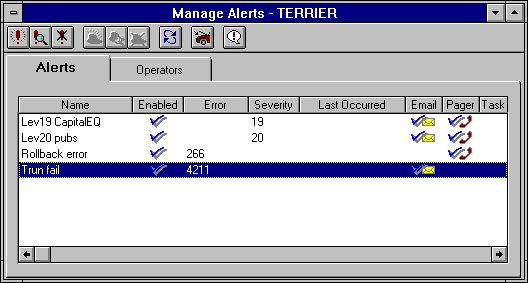 To create an alert
To create an alertSQL Enterprise Manager and the SQL Executive service provide an easy way to set alerts on SQL Server events. SQL Executive monitors the Windows NT application log, watching for an event that qualifies as one of the defined alerts. If such an event occurs, SQL Executive will respond automatically, either by executing a task that you have defined or by sending an e-mail and/or a pager message to an operator you have specified. You can use this capability to set up alerts on replication events.
 To create an alert
To create an alert

The Manage Alerts window appears, with the Alerts tab selected.


The New Alert dialog box appears.

The Enabled box is selected by default. In most cases, this is the appropriate setting. It is useful to clear this option if you want to create the alert now but do not want it to take effect until later.
To select from a list of error messages, or to create a custom error message, select Error Number, select the browse button, and complete the SQL Server Messages dialog box that appears. In this dialog box you can view a list of messages, and you can filter the list to display only replication (or other) messages.

Note that an alert will occur only if the specified event is entered in the Windows NT application log.
For information about which events are logged, and to learn how to filter the list of messages displayed in the SQL Server Messages dialog box, see Chapter 17, Managing Alerts.
For a list of error numbers and a discussion of severity levels, see Part 8, Troubleshooting.
A task can invoke a command execution or a Transact-SQL statements. For information on creating tasks, see Chapter 16, Scheduling Tasks.
You can enter up to 255 characters. Note that this is any text you want to add to the alert. Do not type in the actual error message text.
For example, suppose you type 8 in this box. Later, five alerts that meet the alert definition occur within a period of eight seconds or less. Only one alert is sent to the operators specified in step 9.
A solid envelope or solid telephone icon indicates that the operator already has address information of that type defined. An outline envelope or outline telephone icon indicates that the operator does not have address information of that type defined.
If the necessary operators have not yet been created, the list will be empty. For instructions on creating operators, see Chapter 17, Managing Alerts. You can continue with alert creation, since you will be given the opportunity later, during operator creation, to assign this alert to each operator. You can also later edit this alert to add operators, after operators have been created.
The alert is created.
The following messages can be raised by the replication subsystems, and can be used to set up replication alerts.
Message: 14150, Severity: 10, State: 0,
Replication-subsystem: Task 'task_name' succeeded. message
Message: 14151, Severity: 20, State: 0,
Replication-subsystem: Task 'task_name' failed. message
Message: 14152, Severity: 18, State: 0,
Replication-subsystem: Task 'task_name'
scheduled for retry after number attempt(s). 'message'
Message: 14153, Severity: 10, State: 0,
Replication-subsystem: Task 'task_name'
detected the potential for missing jobs on 'message'
where
For more information on alerts, including information on how SQL Server alerts are generated, how to create and manage operators, and how to edit, view, and cancel alerts, see Chapter 17, Managing Alerts.